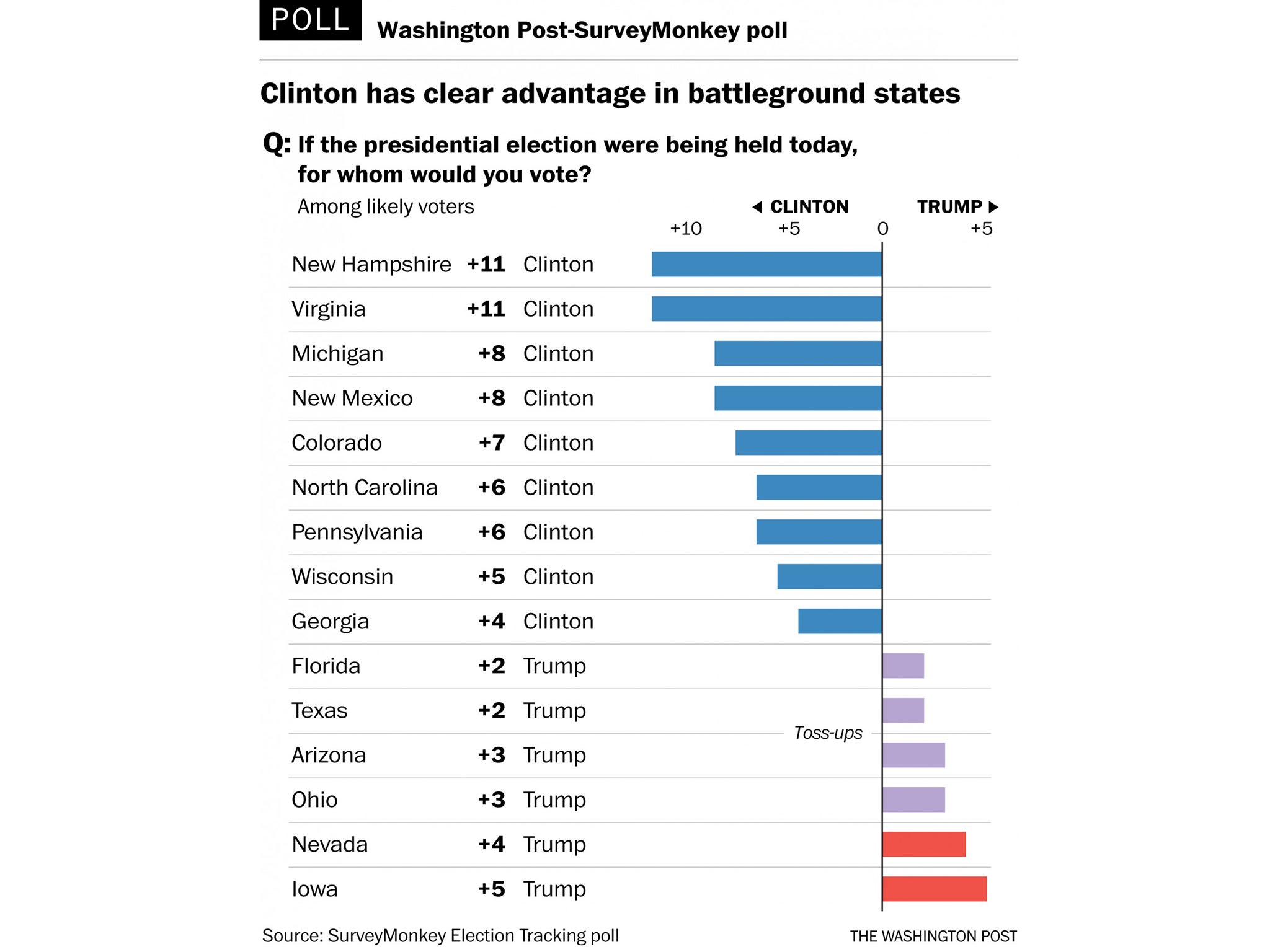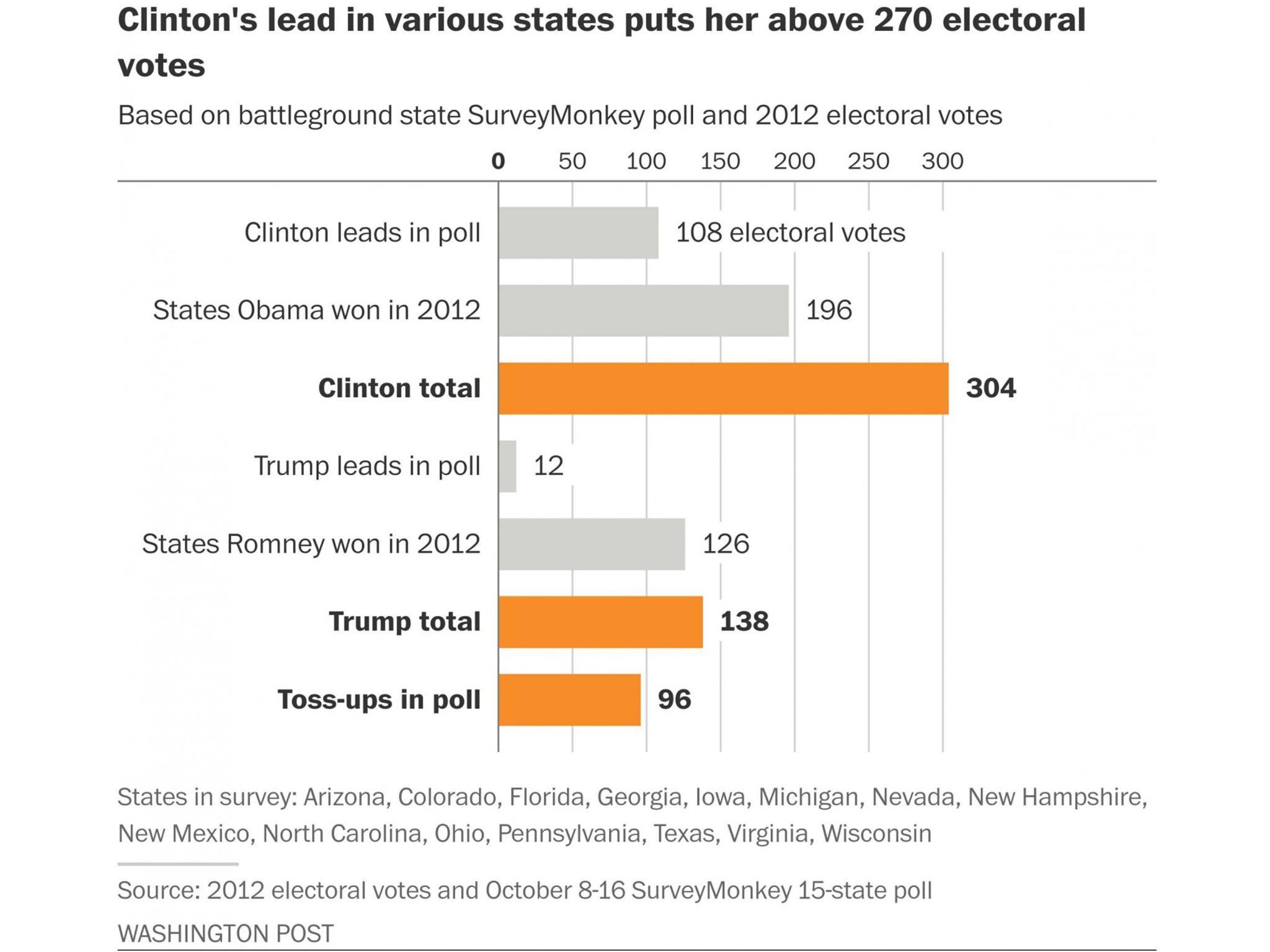Hillary Clinton holds decisive lead over Donald Trump in new battleground polls
- According to a new SurveyMonkey poll of 15 battleground states conducted with The Washington Post, Clinton now holds a decisive advantage over Trump

Your support helps us to tell the story
From reproductive rights to climate change to Big Tech, The Independent is on the ground when the story is developing. Whether it's investigating the financials of Elon Musk's pro-Trump PAC or producing our latest documentary, 'The A Word', which shines a light on the American women fighting for reproductive rights, we know how important it is to parse out the facts from the messaging.
At such a critical moment in US history, we need reporters on the ground. Your donation allows us to keep sending journalists to speak to both sides of the story.
The Independent is trusted by Americans across the entire political spectrum. And unlike many other quality news outlets, we choose not to lock Americans out of our reporting and analysis with paywalls. We believe quality journalism should be available to everyone, paid for by those who can afford it.
Your support makes all the difference.Hillary Clinton holds a decisive advantage over Donald Trump in the competition for votes in the electoral college, leading in enough states to put her comfortably over the 270 majority needed to win the presidential election in November, according to a new SurveyMonkey poll of 15 battleground states conducted with The Washington Post.
Based on the results from the 15 state surveys, along with assumptions of the likely outcomes in other states that have consistently voted for one party or the other, Clinton, the Democratic nominee, holds leads of four percentage points or more among likely voters in states that add up to 304 electoral votes.
Trump, the GOP nominee, has the advantage in states with an estimated electoral vote total of 138. Arizona, Florida, Ohio and Texas, which account for 96 electoral votes, remain as toss-ups. All results in the 15 state surveys are based on ballot tests that include Libertarian Party nominee Gary Johnson and Green Party nominee Jill Stein.
The results underscore the importance for Trump of Wednesday’s final presidential debate, in Las Vegas. National polls have moved in Clinton’s direction since the exchanges began in late September. Her current average margin is seven points in polling averages from the Huffington Post Pollster and RealClearPolitics. The most recent Washington Post-ABC News poll put her national lead over Trump at four points.
The effect of the shift toward Clinton in national polls is evident in the new 15-state study. In late August, The Post, using SurveyMonkey’s online methodology, conducted individual polls in all 50 states among registered voters. At that time, Clinton led in states that added up to 244 electoral votes, while Trump led in states accounting for 126. Toss-up states equaled 168 electoral votes.

The SurveyMonkey surveys also included polls of Senate and gubernatorial races, where applicable, in the same 15 states. The results show two things. First, many Republican Senate candidates are outperforming Trump in their states. Second, that still may not be enough to maintain the GOP’s majority in the chamber.
Democrats need a net gain of five seats to take outright control of the Senate, four to exercise control if Clinton becomes president. The results showed Democrats with leads of four or more points in three states with GOP incumbents: New Hampshire, North Carolina and Wisconsin.
Republican incumbents lead in Florida and Ohio, in the latter by a wide margin. Meanwhile, races in Nevada, for a seat currently held by Democrats, and Pennsylvania, for a seat now in Republican hands, continue to be close. Pennsylvania is emblematic of the problem for GOP Senate incumbents trying to survive in states where Trump is struggling. Clinton leads Trump by six points in Pennsylvania, but the Senate race is even at 47 percent apiece for Republican incumbent Patrick J. Toomey and Democrat Katie McGinty.
Illinois was not included in the survey, but based on other polls, its contested Senate seat appears to be one of the likeliest to shift from Republican to Democrat in November. Republicans also are defending seats in Indiana and Missouri, both of which now have highly competitive races but neither of which was included in the 15-state survey.
The 2016 campaign has produced apparent shifts in several states — battlegrounds and non-battlegrounds — that could foreshadow more permanent changes in future elections. Demographic trends have moved several swing states more strongly in the direction of the Democrats — Colorado and Virginia are prime examples.

States such as Arizona, Georgia and possibly Texas show predicted signs of shifting from traditional GOP strongholds to potential future battlegrounds. The demographic changes would put Republicans at an even greater disadvantage in the future if they cannot find a way to appeal to a changing electorate.
At the same time, the electoral map looks somewhat different from past campaigns, owing to the uniqueness of Trump’s candidacy — the coalition he has attracted and the voters who are repelled by his message and temperament. His relative strength in states with high percentages of non-college graduates and of white voters, such as Iowa and Ohio, is an example of the former. Utah, which has been scrambled this year by Trump’s candidacy, is an example of the latter.
Utah was not included in the SurveyMonkey analysis. But recent public polls suggest that this traditionally rock-solid Republican state is now a competitive battleground. Trump can hardly afford to lose the state’s six electoral votes, given his current disadvantage.
Overall, the results of the 15-state survey underscore Clinton’s wider margin for error in the state-by-state competition over the final three weeks of the campaign, as well as the increasingly tortuous path for Trump to cobble together an electoral-college majority.
Clinton has many paths to 270; Trump has few. This has been the case for some time, based on all available evidence from state and national polls. Trump now needs a clear shift nationally and then a strategy for converting that into state-by-state victories.
Among the states that have moved in Clinton’s direction since the previous 50-state survey are Colorado, Georgia, Michigan, North Carolina and Wisconsin. Of those, the results in Georgia differ from the current average of all recent polls in that state. The Huffpost Pollster average in Georgia gives a Trump a four-point lead, while the SurveyMonkey poll puts Clinton ahead by four points.
Texas is another state that, by historical results, should end up in Trump’s column. The SurveyMonkey results show the state splitting 44 percent for Trump to 42 percent for Clinton. The average of other public polls shows Trump with a larger, although single-digit, lead there. But with virtually the entire Bush family on the sidelines and with an endorsement of Clinton by the Dallas Morning News, Texas has proved to be a more competitive battleground than anyone expected.
The SurveyMonkey results also put Clinton in a stronger position in New Hampshire and North Carolina than other public surveys. Public polls in North Carolina show her with a low single-digit advantage. In New Hampshire, public polls show her ahead but not by the 11-point margin in these findings.
None of that negates the obstacles for Trump. If he were to win all the toss-up states, plus hold on to Georgia, which has consistently voted for Republican presidential candidates since 1996, he would still be 20 electoral votes short of the 270 needed to win. Were he to eke out an additional victory in North Carolina, which has 15 electoral votes, that still would not be enough.
Trump’s campaign has claimed for a long time that, because of his support among white, blue-collar voters, he would be able to make inroads in traditional Democratic territory such as Michigan, Pennsylvania and Wisconsin. The new findings underscore the degree to which he is falling short in those Midwestern battlegrounds. He trails Clinton in Michigan 45 percent to 37 percent, in Pennsylvania 46 percent to 40 percent and in Wisconsin 43 percent to 38 percent.
Two states remain among Trump’s best among the battlegrounds. He leads Clinton by five points in Iowa and by four points in Nevada, a state where other polls have shown Clinton with a slight edge. In Ohio, the results are Trump at 44 percent and Clinton at 41 percent. But traditionally Republican Arizona is equally close, with Trump at 44 percent and Clinton with 41 percent.
In state after state, Trump appears to have a relatively low ceiling to his support. Of the 15 measured, he garners 45 percent in two states and at or below 40 percent in eight. Clinton’s lowest is 40 percent in Iowa and Nevada, but she is at 45 percent or more in six states, topping out at 49 percent in Virginia.
The demographic contours of support for Clinton and Trump show some variance from state to state, but there are consistent patterns, beginning with gender differences.
Among women, Clinton leads Trump by four points or more in 14 of the 15 states surveyed. Averaging across all 15 states, her lead over Trump among women is 49 percent to 35 percent. Among men, Trump leads by four points or more in 12 of the 15 states and by 10 points (47 percent to 37 percent) on average across all 15 states.
Trump has comfortable leads among white men in all states except New Hampshire, where he and Clinton are tied. Clinton leads by four points or more among white women in Colorado, Iowa, Michigan, New Hampshire, New Mexico, Pennsylvania and Wisconsin. Trump leads among white women in Arizona, Florida, Georgia, North Carolina and Texas. The two are running nearly even among white women in Nevada, Ohio and Virginia.
Racial divisions are stark. In Georgia, Trump leads among whites by more than 30 points. Among nonwhites, Clinton leads by just over 70 points. In Michigan and Pennsylvania, whites split almost evenly while nonwhites back Clinton overwhelmingly. In Virginia, Clinton’s lead of more than 50 points among nonwhites easily overcomes Trump’s five-point advantage among white voters.
Educational achievement remains a clear dividing line and one of the potential mold-breakers of this campaign. Republicans have generally won the votes of whites with college degrees and those without. This fall, among white voters without college degrees, Trump leads by four points or more in 14 of the 15 states surveyed, most by sizable margins.
Clinton, however, leads among whites with college degrees in 12 of the 15 states. Trump leads narrowly among white college graduates in Georgia, and the two are running about even in Florida and Texas. In Michigan, Ohio and Pennsylvania, Clinton leads Trump by double digits among white voters with college degrees, helping offset losses among those without degrees.
In these battlegrounds, Clinton holds a higher percentage of Democrats than Trump holds among Republicans. Averaging across the 15 states, she wins 92 percent of self-identified Democrats while Trump has support from 85 percent of Republicans. Trump leads among independents by six points (38 percent to 32 percent), while Johnson, the libertarian, averages 20 percent among independents.
The SurveyMonkey poll was conducted online Oct. 8 to 16 among 17,379 likely voters across 15 states, with between 569 and 1,702 respondents in each state. No margin of sampling error is calculated, as this statistic is applicable only to randomly sampled surveys.
The Washington Post
Join our commenting forum
Join thought-provoking conversations, follow other Independent readers and see their replies
Comments